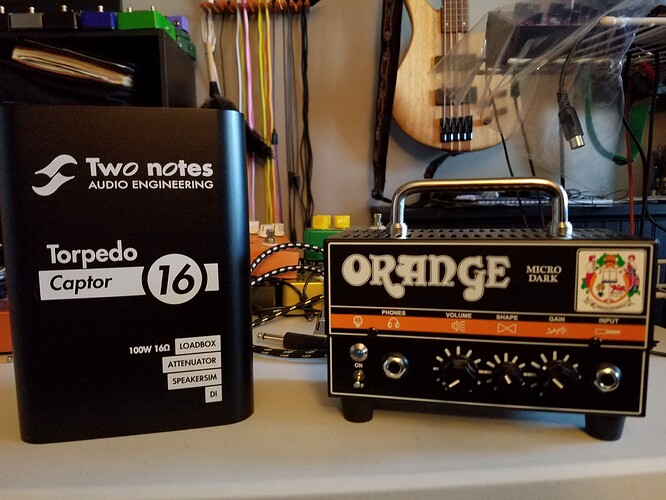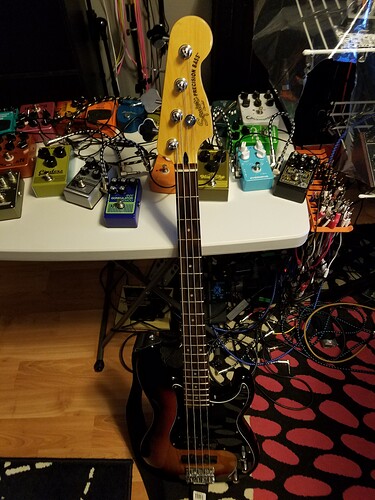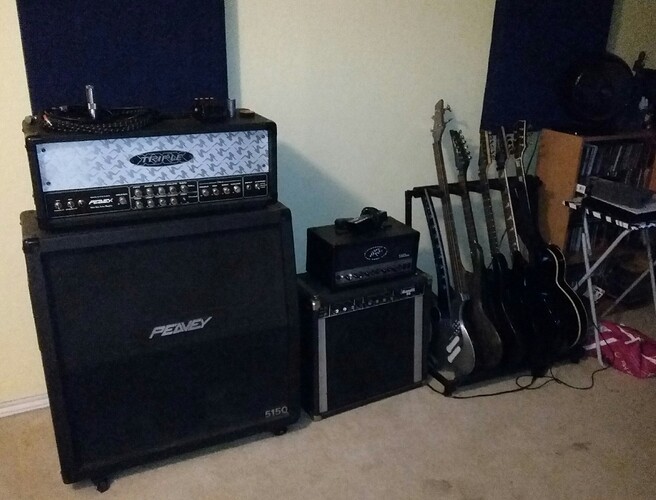Nah, I got a rebel 30. Which is instant wall shaker!
Ah, ok. But I see that it has a 1w switch. Does that not work so well for you? Or is it affecting headroom more than volume? Also, since you have the Captor, you can use the -20db attenuator on it, since the speaker cable seems to be easily accessible on yours (not the case on my Vox, which is a bummer). Still too loud?
The 1 watt does only headroom from my experience.
Yeah, an attenuator has helped for sure!
Really digging the Micro Dark. Diming gain and shape just sounds so bad ass. Some people say it doesn’t clean up very well, but I got some very nice cleans out of it, no problem. The shape knob is cool and all, but I think an EQ pedal is a must for it. Still need to see how it takes pedals. And I know I can also run the FX out to FX in on my Tweaker for the ALL T00BZ experience, so gotta try that as well.
No experience with the Captor yet, since I can’t keep myself from just jamming out so far.
I used to mix my amp and torpedo in with my pod HD 500 to make the pod sound palatable. Now I mix my helix in with my amp to make the amp palatable.
I can’t quite seem to nail the tones I want out of that amp, like 90% there, but it’s still not quite cutting it for me for some reason.
Well this place is quiet so I will answer myself!
I am pretty happy with the helix.
It is a lot better than older gen line 6 stuff I had used. And I tried a/b ing some other amp sims, and I like it better than gr5 for sure.
It gets real close to the uad sims too. I compared the Friedman models in both, I could tweak both to be real close. But there was a slight tonal difference between the 2, but the cab IRs were different in both.
But the uad stuff sounded a bit rounder and thicker maybe.
Pretty subjective tho.
And the helix is way more playable, in that I can switch snapshots and stuff from a midi foot pedal, which is a big deal for me.
How are you using it with your amp? I see that even the LT has a shitload of connections on the back, so all kinds of routings and uses are possible.
Interesting about the UAD comparison. When did those sims come out? I know Helix came out in 2015 or something like that. I’m wondering if we are hitting amp sims quality peak, so to speak. Meaning, that the amps sims/versions that came out in the last couple of years are pretty much there and there’s really not going to be anything mind-blowingly “next level” and it’s just going to be tiny incremental improvements or just things sounding different, but not better?
Hey guys, I cannot keep up with some of this convo on the suble amp differences but I wanted to toss in that I am pretty happy with mine, which is a VHT Special 6 Ultra. Nice and clean if I want it but with a Watt reduction function to get it really gritty even at low volumes. I put my bluesbreaker II in front of it a lot and it does just fine for me for bluesy tones. They are supposed to be really mod-able, it is all through-hole construction. Not fiddled with that yet. If I had more fundage (and space) I would probably look at an AC15 or similar to compliment this. Or a fender reverb of some kind.
I play a LP studio and an ES-175 through it fwiw. My hands are too big for most Fender necks I have tried. Though I like the look of that Jazzmaster.
Yeah, I see a lot of positive feedback on that one.
Updates from me - I finally popped my amp micing cherry (well, at least in this decade). No comments yet on close micing and how that compares to using IRs. Still need to do some proper shoot outs for that. But I can already tell I will be having a lot of fun with room mics. Positioning them in random places around the room and then blending with close mics - instant vibe and character. For sure will be using that for intros/breaks/sparse sections. Probably not for anything very busy. Though maybe some subtle blending of that can help with separation and positioning things front to back.
Also, used the Captor’s attenuator with the Vox and it definitely makes that amp a whole lot more usable. Haven’t tried recording through it just yet. Still lots of things to explore, but not enough time. Baby steps.
I don’t do any micing here, don’t have the ability to go that loud, so keep in mind I haven’t done it in a decade. But
1 I seem to remember micing maybe 2 inches off the grill worked better than right up on it.
2 check the phase of stuff when multi micing, before committing to audio.
As for the helix, it’s got a dry through to send a di, or to an amp or whatever.
So I was doing a wah and some dirt pedals in front of the helix, then through to the amp in.
Sold the amp today tho. Not off amps or anything permanently, just off that particular one for sure!
Links removed, edit post if you need to add them back, not sure I’m understanding this post.
So unless I’m missing something here, the DI is not a true guitar DI, but just the sound of the amp minus the speaker. Because the only thing that’s plugged into the Captor is the amp. But that’s fine, I have a DI box with a THRU, so I was still able to do just that - get 3 signals recorded (guitar DI, amp by itself, and miced cab). The interesting thing so far is I don’t feel like using a real amp + IR gives me significantly better results than using an amp sim with the same IR. After some tweaking, I can get pretty close. There are some differences, but they are in the same ball park and just slightly different. Not really better, just different. So that’s both somewhat disappointing and yet a good thing because like I said before, I’d be pretty happy if I confirm for myself that amp sims are perfectly adequate for my purposes and I should just continue to learn to get the best tones I can out of them. Unfortunately, I kind of liked the closed miced sound more than the other 2. There’s just something pleasing about it.
So the jury is still out. The true test is going to be re-amping a full track and comparing the results to the same track done with amp sims. Because I’m worried that even though I liked the real cab more in this one instance, in the context of the mix, it’ll probably impart some kind of same-ness to all the guitar tracks, since I only have one cab and the Vox. So using IRs can help with separation, maybe.
Speaking of re-amping, I also tested my DIY L2A reamp box. I recorded a DI and a miced cab. Then without touching anything, I ran the DI’d signal from Cubase through it back into the amp and recorded the result. The good news is that it all sounded identical. The bad news is that I did the same thing without using the reamp box, so just running the signal straight from my RME UCX and got the same result. So for whatever reason, with this particular interface, and the Egnater amp, any potential impedance mismatch doesn’t have any effect.
Onwards and upwards.
That’s pretty well expected. Preamps are, in the grand scheme of things, pretty easy to model. You’re mostly talking about a bunch of resistors and capacitors and maybe some tubes or transistors. Tubes can be interestingly non-linear, but not hard to model considering today’s technology. Preamps are (mostly) easy, and you’re not likely to see a massive difference between real and simulated.
What’s hard about amps is the cab and the room, which is why IRs and what they’re loaded in make such a difference. Even then, IRs are a snapshot of the room, and don’t tell the whole story. I think it’s the cab/room part of the equation that has room for improvement over the preamp part.
Amps don’t care about impedance for the most part, pickups are where that matters, which is why DIs are important. Amps are concerned with signal: line level, like from your RME ranges from ~0.5V-2V. Guitars tend to put out 100mV up to maybe 1V on the very top end, and that’s what the amp’s expecting. Line level turned all the way up is probably going to overload the input of the amp and sound like crap, but as long as it’s turned down to a level the amp can deal with, it should sound fine.
Reamp boxes also convert from balanced to unbalanced and usually have a ground lift, but those things mattering are situational compared to the level attenuation.
I think I was talking about the bigger two notes box, the reload maybe?
Anyway, glad you are plugging along. And maybe you are right, at the end of the day maybe the difference will be unnoticeable in a mix as to an amp or a sim, but then it’s just up to your process then, and how you want to go about doing it I guess.
Sims might be less hassle, but using amps is the real deal, and can be more interactive to how you play, if you can get them to be loud enough.
Yeah, you totally called that earlier. As do a lot of people on the internet. And a lot of people seem to swear by their amps in the same scenario (amp + load box + IRs). So I had to see it for myself.
Are there any sims in your opinion that get that part better than others? It seems like the general consensus is that quality IRs still sound better, even though it’s a single static snapshot of the cab/mic/room vs all the complex algorithms that try to mimic the complex interaction between the cabs/mics/positions/room by allowing you to swap things out or move them around.
UCX allows you to set the signal level going from the outs to +4dBu, -10dBV, and Hi Gain (whatever that is). I’ve tried all of them and it seemed like the amp was ok with them all. Of course I could hear the difference in loudness, but I didn’t hear any unpleasant distortion or anything and it seemed like if I were to record and normalize the results, they would sound roughly the same.
Funny, I was reamping with the Egnater when I wrote all that. Hooked up the Vox and got some horrible hum. Flipped the Lift and carried on. So, yeah, running things through the L2A regardless, just for that reason.
Totally, wasn’t having an ‘I told you so’ moment, those are the kind of things you have to prove to yourself. And some people hear a difference - whether it’s real or confirmation bias, who knows. Only way to know for sure where you stand is to do it.
Honestly, it’s the sort of thing I just use and forget about, then get my panties in a twist and do a bunch of research and demo things, and then settle back into a pattern.
I know I don’t particularly like the built in ones in Amplitube or GR5, though I don’t know if that’s the loader or the IRs themselves. Turning off the built in ones and using a third party one was a mind blowing experience. I was like “that is why people don’t like amp sims”.
I’ve had good luck with Ignite’s NadIR and Ownhammer’s IRs. NadIR is cool because you can load two different cabs and blend between them. I like the different mic options with the Ownhammer stuff.
I haven’t used any of the fancy external loaders like Torpedo, as all my amps are terminally analog and it all seems a bit complicated. As I said before, I’m mostly ITB these days anyway. Everything I’ve heard from those units sounds good.
Yeah, that’s sort of the deal - sometimes you gotta turn it down, sometimes the amp’s cool with it. Just depends on how the amp and the line out are built. My personal experience is that the older the amp, the grumpier it is with loud signals. Newer stuff doesn’t seem to care so much. One of those YMMV things.
Heh, I know that, that was more giving props and acknowledging your wisdom.
Same here. I started using IRs with Amplitube early on, so never really fucked around with their cabs/rooms/mics much. Same with NadIR, once I found it years ago, never really looked for any other loader. It’s just perfect.
I only recently bought a bunch of Ownhammer IRs. I think my mistake was relying on random free IRs that I’ve accumulated over the years and not realizing that most of them weren’t that great. Getting some Ownhammer packs recently was pretty eye opening. And it’s only now, after understanding what good IRs sound like, I’m starting to go back to the old packs and finding really interesting cabs. Because sometimes it’s starting to feel like the Ownhammer IRs are almost ‘too good’, if that makes any sense, and some of the random home made ‘lo-fi’ ones somehow have more character and sound better for certain fuzzed out ugly tones.
New addition to the family:
It feels awesome and sounds really good to me. Squire really stepped up their quality lately, in particular with Vintage Modified and Classic Vibe series. I don’t think anyone would blink twice if you slap a Fender (at least MIM) logo on this thing. Spent a couple of hours busting out reggae bass lines on this thing cause that’s the kind of vibe it was giving me.
Anybody messed around with flat wound strings here? I put a set on that P Bass and then it dawned on me that I’d never tried them on guitar. So I put a set on my Tele. It’s… interesting. I don’t know if it’s just the novelty of it at this point or what, but I’m digging it. The conventional wisdom is that they are mostly great for jazz (or retro 50s things, since that’s all that was available back then). But I think they sound cool on single coils. Definitely mellowed that Tele out and it just sounds fuller.



